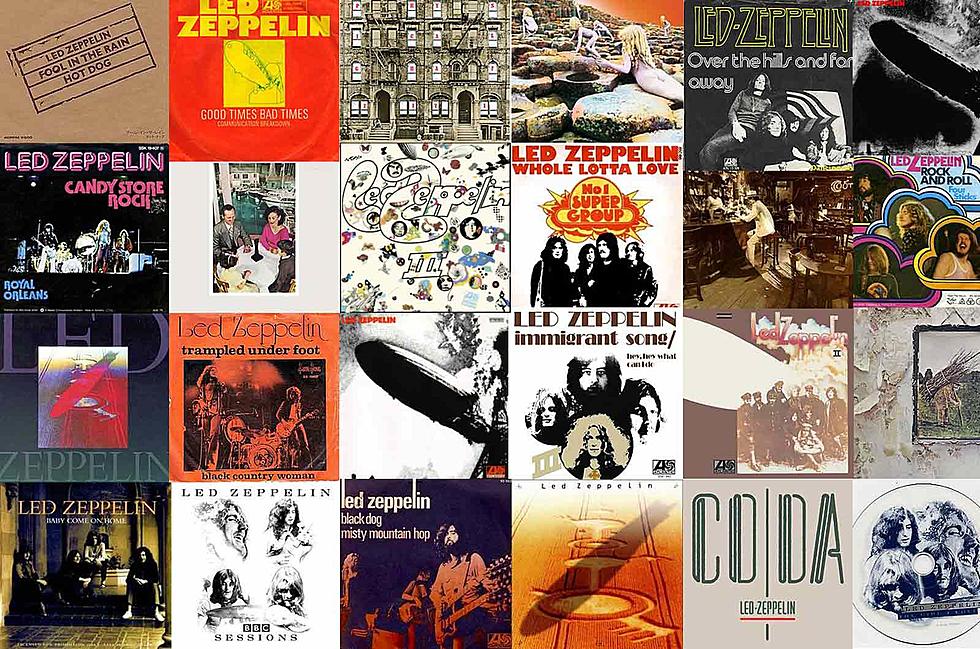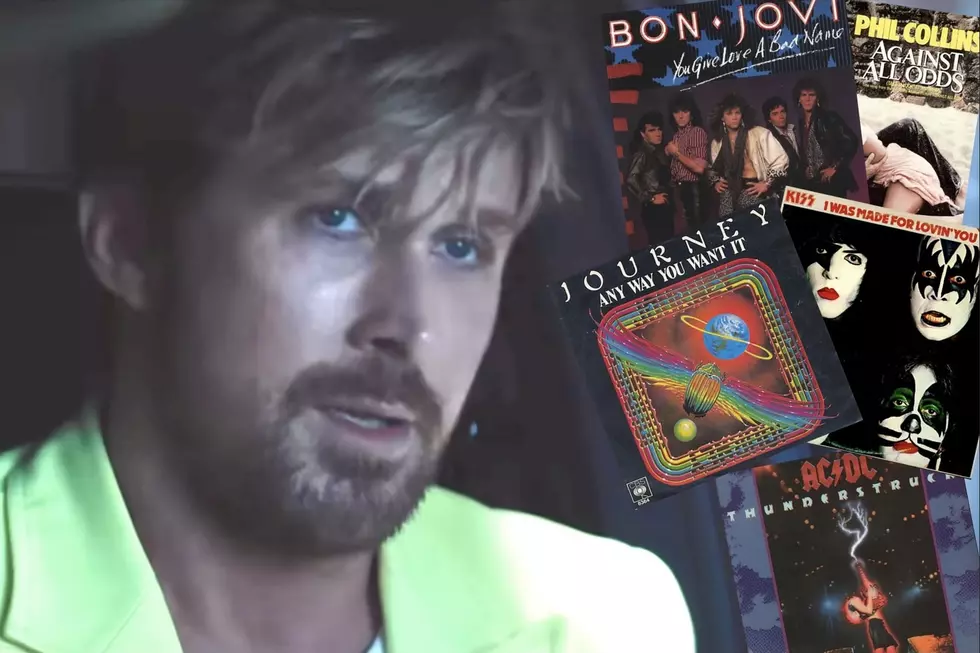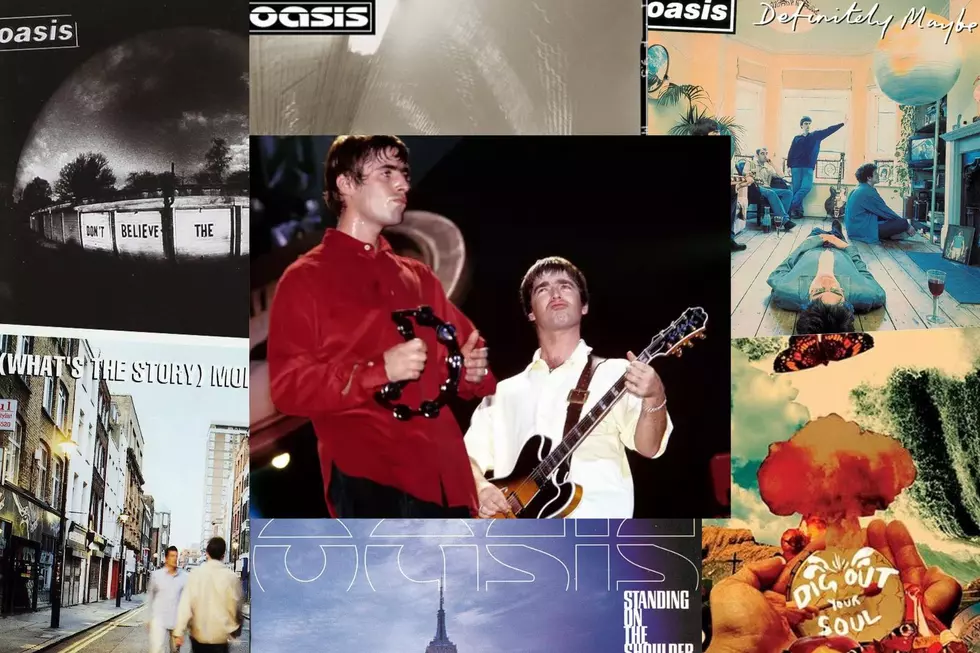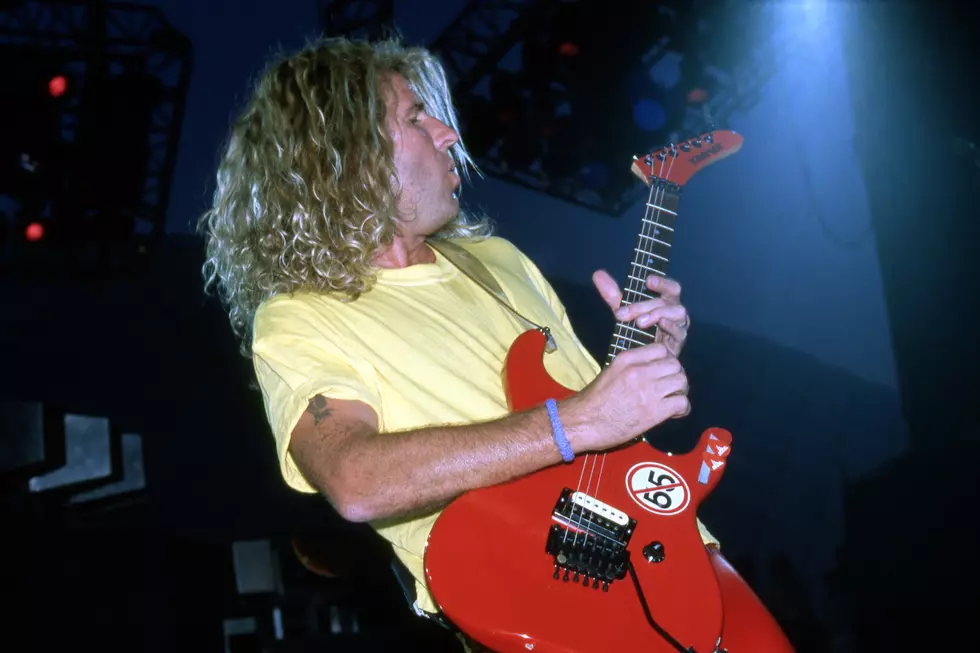
All 92 Led Zeppelin Songs Ranked Worst to Best
Led Zeppelin were around for about a dozen years and released only eight albums during their lifetime, with a later rarities collection bringing their total studio output to nine LPs.
But in that short time, John Bonham, John Paul Jones, Jimmy Page and Robert Plant managed to become rock gods who pretty much reshaped and defined how heavy music sounded going forward. There was a time when they were the biggest band in the world; they're still major rock 'n' roll influences decades after their formation.
Our list of All 92 Led Zeppelin Songs Ranked Worst to Best gathers every track from their nine albums, as well as some odds and ends that have shown up since their breakup in 1980 and the release of Coda in 1982.
We left off most of the bonus songs from the remastered "Deluxe Editions" that are no more than early sketches of tracks that ended up on the official albums under different names. We also left off the 14-second "LA Drone" from the live How the West Was Won because it's no more than incidental intro music. On the other hand, we included the few BBC Sessions songs that aren't found on any other Zeppelin albums.
92. "10 Ribs & All/Carrot Pod Pod," Presence (Deluxe Edition) (2015)
The first half is a pretty piano-based instrumental by Jones; the rest of the band joins him for the second part. It sounds nothing like the heavy Presence that was recorded at the same time. Aimless, as far as these things go.
91. "Key to the Highway/Trouble in Mind," Led Zeppelin III (Deluxe Edition) (2014)
A medley of two old blues songs featuring only Page and Plant during the making of their third album. Most likely never seriously considered for the record since it sounds so tossed off.
90. "La La," Led Zeppelin II (Deluxe Edition) (2014)
Recorded during the Led Zeppelin II sessions, it's easy to hear why it was cut. No way the poppy organ-driven song would sound at home on the riff-fueled album.
89. "The Girl I Love She Got Long Black Wavy Hair," BBC Sessions (1997)
A hodgepodge of vintage blues artists share writing credit with the band on this one. This BBC performance from 1969 is reportedly the only time they played the song. No surprise it disappeared soon after.
88. "St. Tristan's Sword," Coda (Deluxe Edition) (2015)
Recorded around the time of the third album, the rough mix of this instrumental sounds more like an informal jam than anything approaching a finished song. Not much to go on here anyway.
87. "Sunshine Woman," The Complete BBC Sessions (2016)
One of those blues songs from the early days that Zeppelin ended up sharing writing credits with someone else. Probably not by choice, and not worth the effort.
86. "Sugar Mama," Coda (Deluxe Edition) (2015)
Well-covered old blues song with a long history that Zeppelin recorded for their first album. It stayed unreleased for more than 45 years. Unremarkable.
85. "Somethin' Else," BBC Sessions (1997)
Zeppelin used to cover Eddie Cochran's "Somethin' Else" and "C'mon Everybody" in concert, proving they were just as adept at early rock 'n' roll as they were at the blues. Unfortunately, the barely two-minute version of the former song from the BBC Sessions fades out before it has a chance to pick up much speed.
84. "Baby Come on Home," Led Zeppelin Boxed Set 2 (1993)
One too many sound-alike blues songs were recorded for the band's first album, so something had to go. This uninteresting original eventually showed up on the second box set.
83. "Walter's Walk," Coda (1982)
This Houses of the Holy outtake was most likely left off the album because, unlike almost all the songs that were included, it's little more than a lazy half-riff stretched out to four and a half minutes.
82. "Tea for One," Presence (1976)
A strained blues number that closes the band's least bluesy album. Mismatched and pretty forgettable.
81. "Hats Off to (Roy) Harper," Led Zeppelin III (1970)
Based on an old blues song and named after a folksinger friend of the band, the closing track on Zeppelin's third album sounds out of place following the pastoral mood set by the preceding four tracks.
80. "Bron-Yr-Aur," Physical Graffiti (1975)
Page's solo acoustic instrumental from Physical Graffiti originated years earlier, during the sessions for the third album – the same LP that yielded the similarly named but better "Bron-Y-Aur Stomp."
79. "Hots On for Nowhere," Presence (1976)
Led Zeppelin wasn't in a good place when they recorded Presence in late 1975. Plant, for one, was recovering from a car accident. So much of the record sounds detached and unfocused, even with the hard-rock dynamic in full force. "Hots On for Nowhere" merely drifts in the background.
78. "We're Gonna Groove," Coda (1982)
The band used to play this Ben E. King-written cover a lot during the early years. They even had it slotted for their second album at one point. This version from Coda was recorded in 1970 with additional guitar overdubs from 1982. Hard to hear what the big deal is here.
77. "Royal Orleans," Presence (1976)
Zeppelin's seventh album loads its best songs at the top of each side. Much of the rest of it ranges from boring to forgettable. This one falls into the latter category.
76. "Sick Again," Physical Graffiti (1975)
Most of the new songs especially recorded for Physical Graffiti are better than the leftover tracks that fill out the double LP. Not this lumbering rocker about teenage groupies.
75. "Night Flight," Physical Graffiti (1975)
Left off Led Zeppelin IV, where it didn't fit that album's tone. Doesn't fit on Physical Graffiti either.
74. "Boogie With Stu," Physical Graffiti (1975)
Stu is Ian Stewart, who plays piano. The song is Ritchie Valens' "Ooh, My Head." Or close enough to it that the late rocker's mom eventually got a co-writing credit.
73. "Out on the Tiles," Led Zeppelin III (1970)
Forgettable crunch rocker that closes the heavier side of the band's third album. No wonder everyone remembers the acoustic songs more.
72. "Bring It on Home," Led Zeppelin II (1969)
Zeppelin was sued for stealing parts of this Willie Dixon song from Sonny Boy Williamson's version. It wasn't the first or last time. Hardly worth the effort.
71. "Black Country Woman," Physical Graffiti (1975)
Left over from Houses of the Holy, this acoustic song sounds like something from Led Zeppelin III. No wonder it took a while to find a home.
70. "Black Mountain Side," Led Zeppelin (1969)
It's easy to overlook this slight instrumental on Side Two of Zeppelin's debut album. The song – an arrangement of a traditional folk tune – certainly sounds like nothing else on the record. It was later combined with another instrumental on a superior live version released on the 1990 box set (see below).
69. "Carouselambra," In Through the Out Door (1979)
What's going on here? Heavy-handed synths, incomprehensible lyrics, and a groove that swerves into a few different directions ... all of which goes on for an ass-numbing 10 and a half minutes.
68. "Southbound Saurez," In Through the Out Door (1979)
Page and Bonham were MIA during much of the prep work for Zeppelin's last album before their split. So this tossed-off song hinges on Jones' rolling piano and Plant's restrained vocals.
67. "The Crunge," Houses of the Holy (1973)
Not a song but a three-minute attempt at a funk jam a la James Brown. Crunge? More like cringe.
66. "Down by the Seaside," Physical Graffiti (1975)
Physical Graffiti consisted of half new songs and half leftovers from earlier albums. The country-ish "Down by the Seaside" was intended for the fourth album but didn't make the final cut.
65. "You Shook Me," Led Zeppelin (1969)
This is why critics hated Zeppelin when they first appeared. Overwrought blues that was probably ripped off from Jeff Beck's similar take on a WIllie Dixon-penned song that Beck released nine months earlier. Skip both and go for Muddy Waters' original instead.
64. "Darlene," Coda (1982)
Likely left off In Through the Out Door because its homages to classic rock 'n' roll didn't fit in with that album's end-of-the-'70s weariness. Sounds good on Coda, though, even though it's sorta directionless.
63. "Candy Store Rock," Presence (1976)
Zeppelin's rockabilly moves on an album mostly buried in lifeless rhythms and prog half-steps suffer from the wall of murk that weighs down so much of the LP.
62. "For Your LIfe," Presence (1976)
There's not a whole lotta memorable songs on the band's seventh album. This one just barely makes it, thanks to its slinky, slippery riff.
61. "Bonzo's Montreux," Coda (1982)
Another Bonham drum solo (see "Moby Dick" later), this one recorded in 1976 and included on Coda along with some electronic flourishes provided by Page. It was remixed and combined with "Moby Dick" on the 1990 box for a drum-solo extravaganza.
60. "Wearing and Tearing," Coda (1982)
A tough, late-period rocker left off In Through the Out Door but resurrected on the Coda outtakes collection three years later. Zeppelin goes punk.
59. "White Summer/Black Mountain Side," Led Zeppelin (1990)
Page recorded "White Summer" on the last Yardbirds album and later combined it with another instrumental, "Black Mountain Side" from Zeppelin's debut, during early shows. This medley from the BBC first showed up on the 1990 box set.
58. "I'm Gonna Crawl," In Through the Out Door (1979)
A sluggish closer to the band's career but also a fitting one, since the last song on their final album together is the closest thing to the blues, bringing it all, in a sense, full circle.
57. "Ozone Baby," Coda (1982)
One of the more tuneful songs on the odds-and-ends grab bag Coda. Recorded at the same time as In Through the Out Door, presumably left off because it's more straightforward than anything else on the album.
56. "Poor Tom," Coda (1982)
A leftover from the Led Zeppelin III sessions and like many of Coda's songs, it sounds a bit formless and unfinished. Still, not bad as far as outtakes go.
55. "I Can't Quit You Baby," Led Zeppelin (1969)
Of all the blues numbers the band recorded in its early years, Willie Dixon's "I Can't Quit You Baby" probably comes closest to the real thing. They didn't even bother giving themselves a songwriting credit either.
54. "Your Time Is Gonna Come," Led Zeppelin (1969)
A mix of psychedelic freak-out music, traditional blues, and gentle folk, "Your Time Is Gonna Come" may be the most musically confused song in Led Zeppelin's catalog. It's pretty good, though.
53. "Hot Dog," In Through the Out Door (1979)
It's a throwaway, but given the dark times surrounding the making of their final album together – Page and Bonham were mired in various substances, Plant was grieving over his late son – this old-time rock 'n' roll goof lightens an otherwise heavy load.
52. "The Lemon Song," Led Zeppelin II (1969)
It's bloated, they ripped it off and it's served as the launching point for adolescent come-ons for decades. But "The Lemon Song" sure packs some major heaviness into its six blues-soaked minutes. The band later had to give Howlin' Wolf a co-writing credit.
51. "That's the Way," Led Zeppelin III (1970)
One of Zeppelin's prettiest songs and an anchor to the second side of the band's rustic third album. "That's the Way" features what may be the band's most reserved performance. Nothing wrong with that.
50. "Living Loving Maid (She's Just a Woman)," Led Zeppelin II (1969)
At barely two and a half minutes, "Living Loving Maid" is often dismissed as the song that immediately follows the better "Heartbreaker." But it's not the throwaway it appears. Just listen to that riff.
49. "In the Light," Physical Graffiti (1975)
There are lots of big songs on the band's sixth album. This is one of the biggest. Clocking in at almost nine minutes and guided by Jones, "In the Light" is so epic, that Zeppelin never even attempted it onstage.
48. "Custard Pie," Physical Graffiti (1975)
The opening track on Physical Graffiti pretty much distills the double album into four-and-a-half snaky minutes. There's a clavinet, a wah-wah-powered solo, and a hoarse Plant towering above it all.
47. "Bron-Y-Aur Stomp," Led Zeppelin III (1970)
Named after the electricity-free cottage in Wales the band camped out in during the writing of the third album, "Bron-Y-Aur Stomp" is part acoustic revelry, part front-porch jam session. The more pastoral instrumental "Bron-Y-Aur" was recorded at the same time but not released until Physical Graffiti.
46. "Celebration Day," Led Zeppelin III (1970)
Led Zeppelin III is best known as the band's acoustic album. This stuttering electric surge defiantly kicks against all that. They liked the song so much that they named their 2012 live album after it.
45. "Hey, Hey, What Can I Do," Single (1970)
Led Zeppelin's only non-album B-side (it was the flip of "Immigrant Song") stems from their third, partly acoustic LP. "Hey, Hey, What Can I Do" would have fit perfectly nestled somewhere on Led Zeppelin III's second side.
44. "In the Evening," In Through the Out Door (1979)
The opening track on the band's last album (not counting the odds-and-ends Coda, released after Zeppelin broke up) is its toughest song. Too bad not much else rocked as hard.
43. "Moby Dick," Led Zeppelin II (1969)
Yes, it's a drum solo, but what a drum solo! Maybe the best one ever laid down on record. Plus, Page – as he does throughout Led Zeppelin II – provides a killer riff for his bandmates to launch from.
42. "The Wanton Song," Physical Graffiti (1975)
One of Physical Graffiti's new songs and an indication of where they were heading on their next album, Presence. Page's slippery riff is the key here, but the rest of the band isn't too far behind.
41. "Friends," Led Zeppelin III (1970)
A sign of things to come from Plant, as he and Page write a world music song years before anyone knew what that was. Indian influences (including Bonham on tabla) are all over this globe-hopping adventure.
40. "Four Sticks," Led Zeppelin IV (1971)
More of a musical novelty than a song, "Four Sticks" takes its name from its concept: Bonham plays the song with four drumsticks instead of the usual two. Its tricky time signatures guaranteed very few live performances.
39. "Thank You," Led Zeppelin II (1969)
Proving they weren't just a rock 'n' roll riff machine, Led Zeppelin busted out this love song, which Plant wrote for his wife, on their second album. It was the first time he penned lyrics all by himself.
38. "The Rover," Physical Graffiti (1975)
Like several songs on Physical Graffiti, "The Rover" was recorded for an earlier album and resurrected for the 1975 double LP. This one comes from the Houses of the Holy sessions but perfectly fits the later record's monster tone.
37. "How Many More Times," Led Zeppelin (1969)
One of the band's earliest songs and one with a sketchy history, seeing that it incorporates lyrics, refrains, and even a slightly tweaked title from a handful of earlier blues numbers. Still, it swings, and Page hauls out his bow for a trippy midsection.
36. "Dancing Days," Houses of the Holy (1973)
Led Zeppelin were performing "Dancing Days" live long before it made its official debut on Houses of the Holy: There's even a version from an entire year earlier on the How the West Was Won concert album that documents a pair of June 1972 shows. Fine-tuned by this take.
35. "Travelling Riverside Blues," Led Zeppelin (1990)
Zeppelin's reworking of a Robert Johnson blues song first showed up on the 1990 box as one of the set's few previously unreleased tracks. It later appeared on 1997's BBC Sessions, since it was first broadcast on John Peel's show in 1969. A searing performance by the entire band.
34. "All My Love," In Through the Out Door (1979)
One of Led Zeppelin's best love songs isn't a love song at all but a tribute to Plant's late son, who died in 1977 at age 5. Page was fighting a heroin addiction at the time, so his input is minimal. But Plant delivers one of his best, and most emotional, vocals.
33. "Tangerine," Led Zeppelin III (1970)
Page toyed around with "Tangerine" when he was in the Yardbirds, but finally got around to perfecting the twangy song on Led Zeppelin III, where it's tucked among other acoustic tracks on the album's folksy second side.
32. "Nobody's Fault but Mine," Presence (1976)
Blind Willie Johnson originally recorded "Nobody's Fault but Mine" way back in 1927, but Led Zeppelin reworked the song into a six-minute epic (and gave themselves songwriting credit). A highlight of the often-bloated Presence.
31. "Houses of the Holy," Physical Graffiti (1975)
Like several songs on the double Physical Graffiti, "Houses of the Holy" was a leftover from an earlier album. No surprise where this one was supposed to appear. The only question is why it was left off the 1973 LP.
30. "Ten Years Gone," Physical Graffiti (1975)
Page originally conceived "Ten Years Gone" as an instrumental – evident by the layers and layers of guitars that make up the climax. Plant later added words about an ex who gave him an ultimatum regarding his career. Page was an expert producer; this is one of his best works behind the boards.
29. "Gallows Pole," Led Zeppelin III (1970)
Based on an old folk song Lead Belly covered in 1939, and given a new arrangement by Page and Plant on the band's mostly acoustic third album, "Gallows Pole" strips down to the genre's, and the group's, essentials.
28. "D'yer Mak'er," Houses of the Holy (1973)
A joke song based on the English pronunciation of "Jamaica," "D'yer Mak'er" folds into itself as a heavy rock band's version of reggae. One of the few times on record where Led Zeppelin lightened up a bit.
27. "The Song Remains the Same," Houses of the Holy (1973)
The opening track to the band's fifth album shifts gears a bit from the previous LP's relatively straightforward rock 'n' roll. Like the rest of Houses of the Holy, "The Song Remains the Same" reaches for more skewed spaces.
26. "Fool in the Rain," In Through the Out Door (1979)
Led Zeppelin wasn't exactly rock's most carefree band. But the best song from the final album they recorded is a breezy case of mistaken identity that brushes away their usual seriousness. Bonham's percussion break is one of classic rock's all-time best.
25. "The Ocean," Houses of the Holy (1973)
The closing song on Houses of the Holy doesn't push the mammoth lengths of some of the album's other tracks, but it's almost as epic in scale. A fitting end to what may be the band's leanest LP.
24. "Going to California," Led Zeppelin IV (1971)
Like "The Battle of Evermore," "Going to California" unplugs Zeppelin from the electric charge that powers most of their fourth album. The song is reportedly about Joni Mitchell, whom Plant had a massive crush on.
23. "What Is and What Should Never Be," Led Zeppelin II (1969)
One of the first songs recorded for the second album and another monster riff-oriented track from the rifftastic Led Zeppelin II. Listen to this one on headphones for the ultimate experience. Page's ear for detail as a producer was getting sharper and sharper.
22. "Misty Mountain Hop," Led Zeppelin IV (1971)
There are several references to J.R.R. Tolkien's work sprinkled throughout Zeppelin's catalog. This song takes its name from a mountain range in The Hobbit, though the lyrics have more to do with a 1968 London drug bust.
21. "Trampled Under Foot," Physical Graffiti (1975)
Inspired by Stevie Wonder's "Superstitious," Led Zeppelin's funkiest song was the only single released from the two-LP Physical Graffiti. One of the band's most radio-ready tracks spotlights Jones' relentless clavinet, the album's not-so-secret weapon.
20. "The Battle of Evermore," Led Zeppelin IV (1971)
More The Lord of the Rings references, this time with former Fairport Convention member Sandy Denny adding celestial vocals to the all-acoustic recording. A lovely bridge between "Rock and Roll" and "Stairway to Heaven" on the mammoth fourth album.
19. "Babe, I'm Gonna Leave You," Led Zeppelin (1969)
Page and Plant based their version of "Babe, I'm Gonna Leave You" on Joan Baez's live take from 1962, a song the singer-songwriter claimed was traditional. It wasn't, so Led Zeppelin ended up giving Anne Bredon back royalties and co-writing credit years later. Either way, it's an early key track by the band.
18. "In My Time of Dying," Physical Graffiti (1975)
Based on a traditional gospel song, and extended to more than 11 minutes on Physical Graffiti (the longest song in Zeppelin's catalog), "In My Time of Dying" is acoustic blues given a full electric treatment that menacingly charges forward. A monumental performance.
17. "Good Times Bad Times," Led Zeppelin (1969)
The opening song from Zeppelin's first album and their first single. So, in effect, pretty much everyone's introduction to the band. And what a remarkable intro, even if its relatively short length and straightforward pop structure barely hint at the group's breadth.
16. "Achilles Last Stand," Presence (1976)
The closest Led Zeppelin got to prog, the opening track to their fatigued seventh album clocks in at more than 10 and a half minutes and marches forward unlike almost anything else in their catalog.
15. "Since I've Been Loving You," Led Zeppelin III (1970)
The only song on Led Zeppelin III that might have fit on their first two albums. No surprise since it was one of the first tracks recorded for this LP. A lengthy blues jam that could've been written decades earlier but is credited to Jones, Page and Plant.
14. "Communication Breakdown," Led Zeppelin (1969)
An early concert favorite that gave the band freedom to play around – especially Page, who recycled a similar-sounding Yardbirds-era solo for the influential one perfected here.
13. "Over the Hills and Far Away," Houses of the Holy (1973)
A lot is going on here in less than five minutes, starting with the acoustic guitar that ushers in the song and ending with the full-band electric assault that carries "Over the Hills and Far Away" far from its initial pastoral bliss.
12. "No Quarter," Houses of the Holy (1973)
A Jones showcase from Houses of the Holy that more than any other classic song in Led Zeppelin's catalog relies on mood rather than a riff. It sets an unhurried and deliberate pace from the start and rides it to the howling finale seven minutes later.
11. "The Rain Song," Houses of the Holy (1973)
One of Led Zeppelin's most endearing ballads runs for seven and a half minutes and features Jones on mellotron, a favorite atmosphere-building instrument from the era. Moody, starry-eyed and near-epic in its slow, steady climb.
10. "Ramble On," Led Zeppelin II (1969)
It sounds a little like one of the old blues standards Led Zeppelin was fond of reworking their first two albums, but "Ramble On" is a Page and Plant original based on The Lord of the Rings. Years before Peter Jackson took Tolkien's Middle-earth saga to the Oscars, Zeppelin was all over Gollum and Mordor.
9. "Heartbreaker," Led Zeppelin II (1969)
That riff pretty much seals the song's legacy, but a lot is going on in its four quick minutes, most of it based around Page's guitar. And just when you think you've heard everything "Heartbreaker" has to offer, Page tosses off a 45-second solo that ranks among rock's all-time greatest.
8. "Black Dog," Led Zeppelin IV (1971)
The band's fourth album plays like a Zep primer, with one great song after another. "Black Dog" opens the LP and serves as one hell of an introduction to everything that's on the way. It was even released as a single, making it to No. 15. Jones wrote that monster riff specifically to trip up fans.
7. "When the Levee Breaks," Led Zeppelin IV (1971)
Like a lot of Led Zeppelin songs, "When the Levee Breaks" stems from an old blues number (this one by Memphis Minnie). And like a lot of Led Zeppelin songs, the band had to share songwriting credit (Minnie first recorded it in 1929). Zeppelin take "Levee" to a whole other place, thanks to Bonham's powerhouse drums, achieved by recording him at the bottom of a stairwell.
6. "Rock and Roll," Led Zeppelin IV (1971)
There are so many arena-ready anthems on Led Zeppelin's fourth album, there's no surprise why it's their most popular (and best) LP. The record pretty much doesn't let up from the start, and this early song (Side One, Track Two) is a glorious straightforward rock 'n' roll song celebrating – what else? – rock 'n' roll.
5. "Immigrant Song," Led Zeppelin III (1970)
Led Zeppelin's third album is mostly known for its stripped-down, acoustic tone. Not this charging song, the opening track that serves as the storm before the calm. It's all Vikings, earth-trampling guitars and a stuttering riff that explodes from the speakers. And it hit the Top 20 on the singles chart.
4. "Dazed and Confused," Led Zeppelin (1969)
Page used to play "Dazed and Confused" at latter-day Yardbirds shows. He borrowed the basic parts of the song from a relatively obscure American folksinger named Jake Holmes but beefed up the arrangement with new lyrics (penned by Plant) and a solo performed on his Telecaster with a violin bow.
3. "Kashmir," Physical Graffiti (1975)
There were rock 'n' roll epics before "Kashmir," and rock 'n' roll epics after "Kashmir." But few pack the colossal wave of magnitude that towers over this eight-and-a-half-minute force of nature from the band's sixth album. It's almost prog in scope and a sign of things to come on next year's Presence LP.
2. "Whole Lotta Love," Led Zeppelin II (1969)
Everything about Led Zeppelin can pretty much be summed up in the five-and-a-half-minute opening song from their second album: the awesome riff, the borrowed lyrics, the mid-track freakout, the sheer power and energy of every musical instrument, including Plant's searing vocal. Their only Top 10 single too.
1. "Stairway to Heaven," Led Zeppelin IV (1971)
It's overplayed and second only to "Free Bird" when it comes to an easy classic-rock target. It also pretty much set the template for every over-baked power ballad that surfaced over the next two decades. But there's no denying the timeless pull of "Stairway to Heaven." From the soft, pastoral intro to the awesome guitar solo that nearly capsizes the ending, it's a truly monumental piece of work.
Top 10 'Leftovers' Albums
Gallery Credit: Bryan Wawzenek
More From Ultimate Classic Rock









